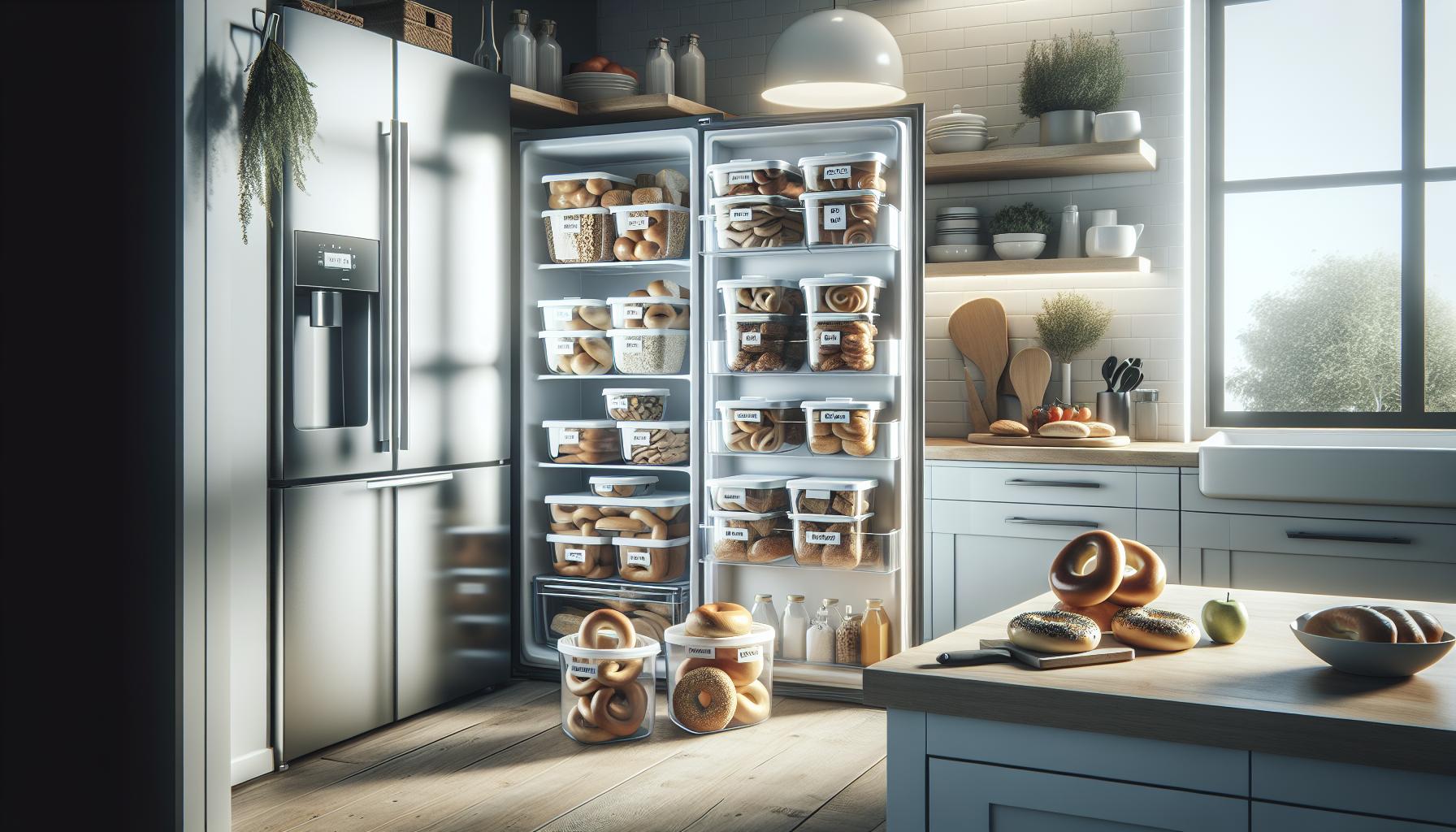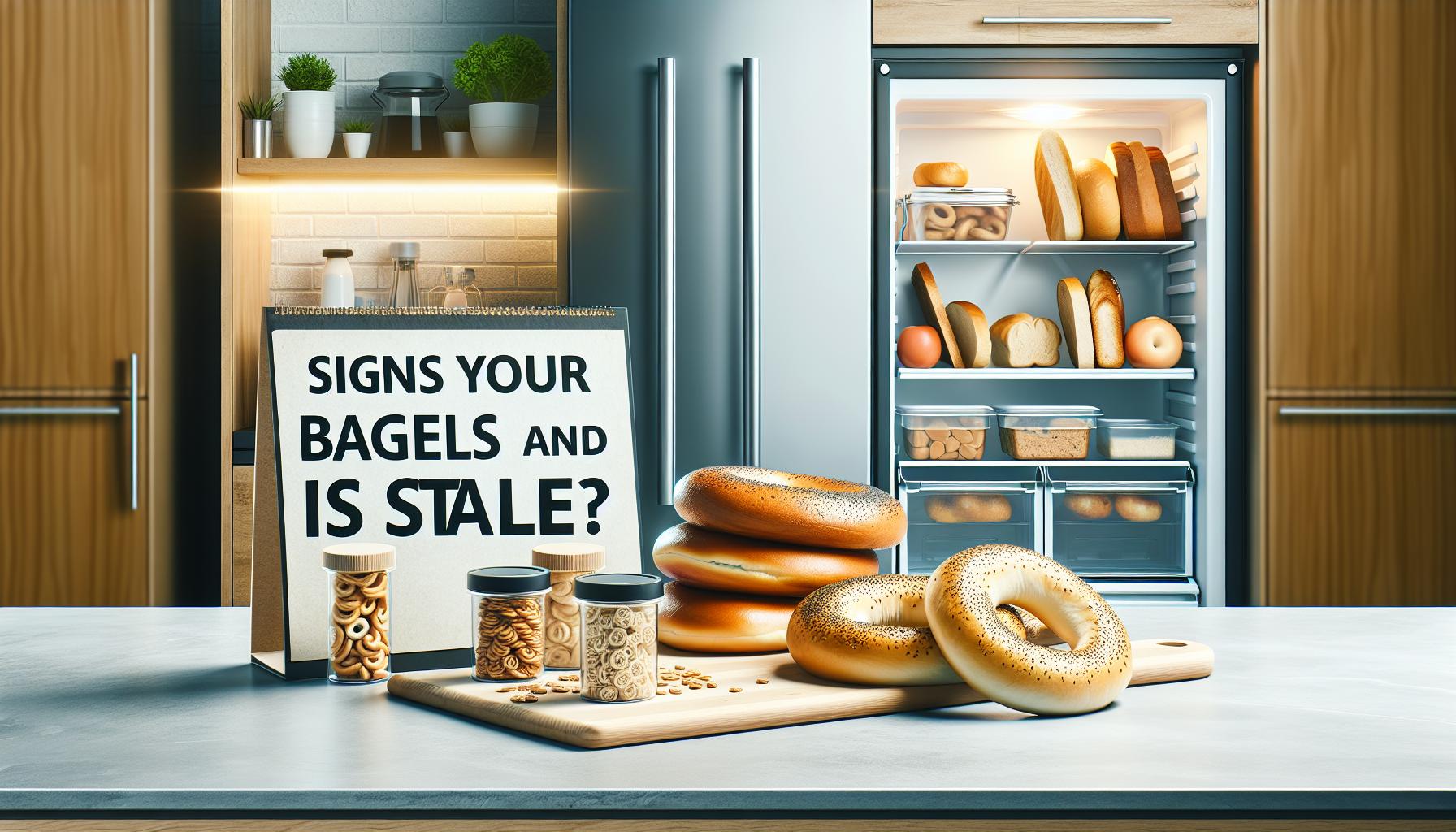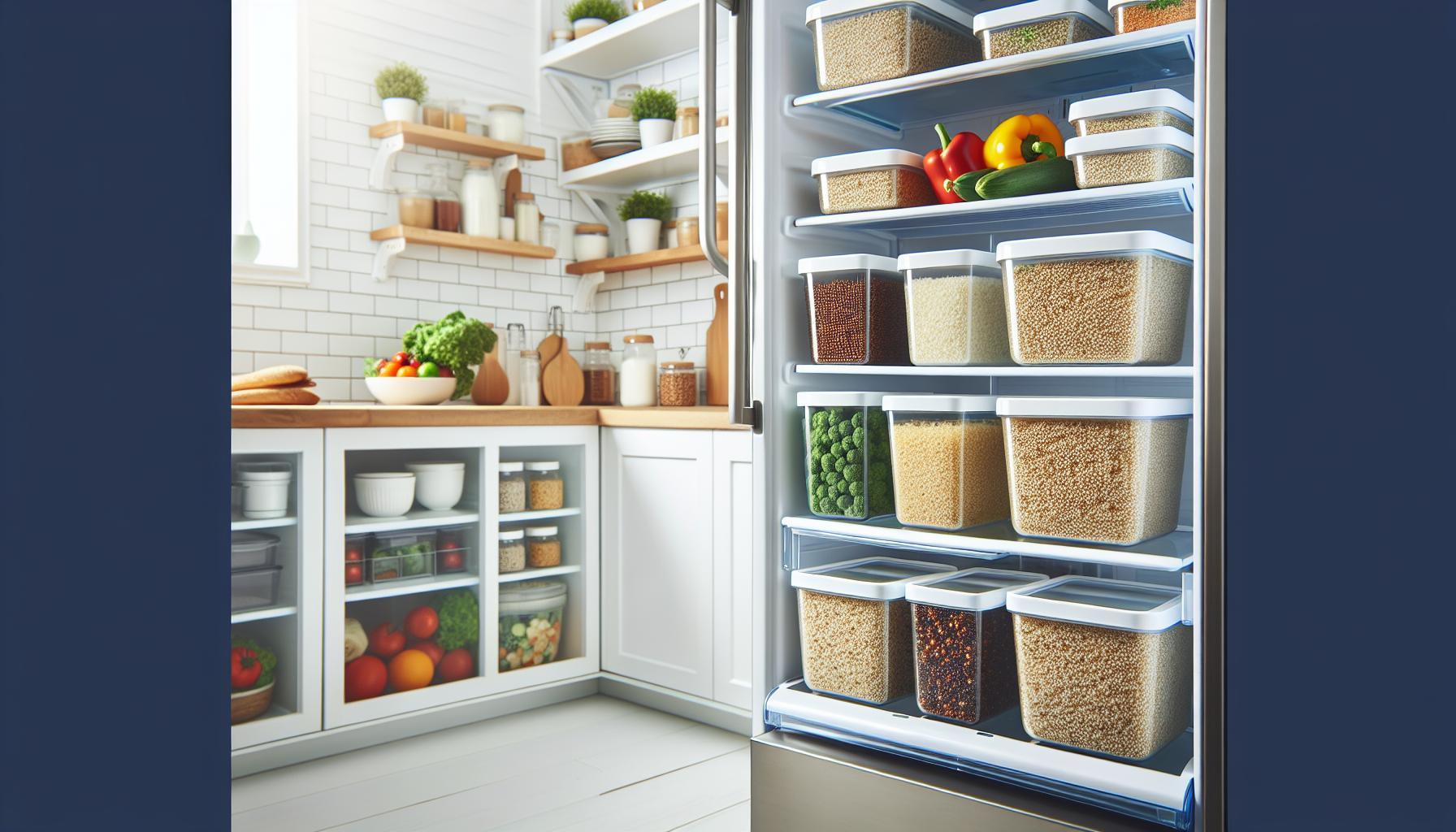Did you know that the way you store your bagels and bread can significantly extend their freshness? For many, the joy of biting into a perfectly soft bagel or a slice of homemade bread can quickly turn to disappointment when they discover it’s stale. Understanding how long these beloved staples last outside of the fridge is crucial not just for taste but also for food safety.
In this article, we’ll unravel the time frames you can expect for bagels and bread when left at room temperature, along with effective storage tips to keep them fresh for longer. Whether you want to savor a weekend baking project or simply avoid waste, knowing how to properly store your baked goods is key to enjoying every last bite. Dive in to discover practical guidelines that ensure your favorite treats stay delightful and delicious!
How Long Do Bagels and Bread Last Outside the Fridge?
Bagels and bread are beloved staples in many households, but knowing how long they can sit out without spoiling is essential for both taste and safety. Generally, bagels and bread can last up to two days at room temperature when stored properly, although this timeframe can vary based on humidity and the specific ingredients used. For instance, homemade bread often lacks preservatives found in store-bought varieties, meaning it may stale more quickly, whereas commercial bagels might contain additives that extend their shelf life.
To maximize freshness, it’s best to store these baked goods in a cool, dry place away from direct sunlight. A paper bag or a linen cloth can offer adequate protection while allowing the bread to breathe, preventing the development of mold. It’s important to avoid plastic bags for long-term storage; while they may retain moisture, this can create an environment conducive to mold growth, particularly in warm conditions.
When assessing whether your bagels or bread are still good to eat, engage your senses: both touch and smell can reveal quality signs. If the bread feels hard or stale, or if there’s an off-smell, it’s wise to discard it to avoid unpleasant surprises. Always err on the side of caution when in doubt about freshness, as consuming stale or moldy products can lead to foodborne illnesses.
The Best Storage Practices for Bagels and Bread
To ensure your bagels and bread maintain their flavor and texture, proper storage is essential. One effective approach is to utilize a cool, dry place in your kitchen, away from direct sunlight and heat sources. A paper bag or a cotton linen cloth is ideal for this purpose, as they allow air circulation while protecting from moisture and light, both of which can contribute to staleness and mold growth. For longer storage, consider using a bread box, which strikes a balance between humidity and airflow.
When it comes to bagels specifically, they are best stored at room temperature for up to two days. After this period, if you’re not planning to consume them immediately, freezing is a fantastic option. Sandwich them individually in plastic wrap and place them in an airtight container or a heavy-duty freezer bag to avoid freezer burn. Ensure to mark the container with the date, as frozen bagels can last for about three months while maintaining their quality.
Bread, on the other hand, should also follow a similar pattern. Home-baked bread, often free from preservatives, tends to break down faster than store-bought varieties, so keep an eye on its freshness. If sliced, revive stale bread by spritzing it lightly with water and heating it in the oven for about 10 minutes at 350°F (175°C). This simple technique can bring back its original softness and flavor, making your meal more enjoyable.
In summary, the best practices for storing bagels and bread revolve around keeping them in an optimal environment to minimize staleness. This approach not only helps in maintaining flavor but also ensures a delightful texture when you finally indulge in these delicious baked goods.
Signs Your Bagels and Bread Are Stale
Recognizing the signs that bagels and bread have gone stale is vital for maintaining their delicious flavor and enjoyable texture. Freshly baked bagels and bread offer an enticing aroma and a satisfying crust, but once they start losing these qualities, it’s time to examine their condition closely. One of the most notable indicators of staleness is a change in texture; if the crust becomes excessively hard or the inside feels dry and crumbly instead of soft and pliable, it’s a clear sign that you’re dealing with stale baked goods.
Another telltale sign is the aroma. Fresh bagels and bread should emit a warm, inviting smell. If you notice a lack of fragrance or an unpleasant odor, it could signify that your bread or bagels are past their prime. Mold is another significant red flag; even if the baked item appears visually fine, the presence of green or black spots is an undeniable sign that it should be discarded. Always prioritize safety; consuming moldy bread can lead to health issues.
Furthermore, taste can also provide clues about freshness. If your bagels or bread taste off or have a flat flavor, it might be time to retire them from your kitchen. The presence of an unpleasant aftertaste can indicate that they are stale or have started to spoil, even if they don’t show visible signs of mold or hardness. When in doubt, trust your senses to guide you; if something seems off, it’s best to err on the side of caution and avoid consumption.
Keeping an eye on these indicators will help you enjoy your baked goods at their culinary best, ensuring that every bite is as delightful as the last.
Tips to Keep Bagels and Bread Fresh Longer
To prolong the freshness of bagels and bread, implementing proper storage techniques is crucial. These baked goods are particularly susceptible to staleness due to their moisture content. Begins by choosing the right storage materials. For optimal results, use a breadbox or a paper bag, which allows for some air circulation while keeping moisture inside. Avoid plastic bags for long-term storage, as they trap humidity and can promote mold growth.
Another effective strategy is to slice breads only when necessary. Keeping loaves whole reduces the surface area exposed to air, which slows down the staling process. For bagels, try to store them in a cool, dark place away from direct sunlight to prevent them from drying out. If you don’t plan on consuming them within a few days, consider freezing them. When freezing, wrap each bagel or slice of bread tightly in aluminum foil, followed by a layer of plastic wrap, which helps maintain freshness and prevents freezer burn.
Enhancing Freshness
To keep your baked goods at their best, consider placing a small piece of bread or a few apple slices in the storage container. This technique helps to maintain moisture levels and ward off staleness. Regularly check your stored bread and bagels for signs of condensation or mold, and discard any that appear spoiled to maintain food safety.
By using these guidelines, you can enjoy your bagels and bread for longer, making every bite as delicious as the first.
Optimal Temperature and Conditions for Storage
The ideal storage conditions for bagels and bread can significantly prolong their freshness and prevent unnecessary waste. Both baked goods thrive best in environments that strike a balance between air circulation and controlled humidity. Keeping them in a temperature range of 60°F to 70°F (15°C to 21°C) is optimal. Avoid placing them in the refrigerator, as the cold temperature accelerates the staling process, leading to tough and dry textures. Instead, store them in a cool, dark location, such as a pantry or a cupboard, where they can remain undisturbed.
Selecting the right storage container is also crucial. A breadbox is an excellent choice, as it allows for some airflow while helping to retain a bit of moisture. If a breadbox isn’t available, a paper bag can serve as a suitable alternative. It’s essential to avoid plastic bags for short-term storage, as they can trap moisture and promote mold growth. If you plan on consuming your bagels or bread within three to four days, storing them in paper bags at room temperature should maintain their quality. However, if the duration extends beyond that, freezing is a better option for long-term preservation.
To further enhance freshness and prevent spoilage, consider placing a slice of apple or a small piece of bread in the storage container. These natural moisture-retaining methods help prevent staleness while balancing humidity levels. Regularly check for signs of mold or off odors, and discard any items that show deterioration to ensure food safety and maintain optimal quality. By following these guidelines, you can keep your bagels and bread delicious and inviting for longer periods.
How to Revive Stale Bagels and Bread
Reviving stale bagels and bread can be a simple and effective process that restores their delightful texture and flavor. When baked goods lose their freshness, often due to air exposure, they can toughen and become chewy. Fortunately, there are several tried-and-true methods to bring them back to life.
One of the easiest ways to revive stale bagels is by using water and heat. Begin by lightly moistening the surface of the bagel or loaf with water. This can be done with a damp paper towel or by running it under a faucet briefly. Once moistened, place the bagel or bread in an oven preheated to 350°F (175°C) for about 5 to 10 minutes. This process not only restores moisture but also helps to regain a pleasant crust. Ensure to monitor closely to avoid over-baking, which can lead to the opposite effect.
Alternatively, if you’re short on time, a microwave can offer a quick fix. Wrap the bagel or bread in a damp paper towel and microwave on high for 10 to 15 seconds. Check for softness and repeat if necessary, but be cautious: over-microwaving can lead to tougher results, not to mention that the freshness won’t last long after this method.
For those who prefer a more intense revitalization, consider slicing the bread or bagels and toasting them. Toasting can enhance flavor and improve texture, giving a satisfying crunch to an otherwise stale bite. If you’re making sandwiches, slightly warming the ingredients can add to the experience, making the overall dish feel fresh.
Remember, these revival techniques are particularly effective for bagels and bread that have not been molded or excessively dried out. Always inspect for any signs of spoilage before attempting to refresh them. If in doubt, prioritize food safety and discard any items that appear questionable.
The Impact of Freezing on Freshness
The freezing process can be a game changer for preserving the freshness of bagels and bread, extending their shelf life significantly beyond what can be achieved through refrigeration or keeping them at room temperature. When properly frozen, bagels and bread can maintain their quality for three months or even longer. Freezing helps to halt the staling process, which typically occurs when baked goods are exposed to air and moisture loss.
To successfully freeze bagels and bread, start by ensuring they are completely cool. For bagels, consider slicing them beforehand; this not only makes them easier to toast later but also allows for quicker defrosting. Wrap each bagel or loaf tightly in plastic wrap to prevent freezer burn and then place them in a resealable freezer bag. Removing as much air as possible from the bag will help maintain their texture and flavor. It’s advisable to label your items with the freezing date, so you can track their storage time.
When you’re ready to enjoy your frozen bagels or bread, the defrosting method can directly affect their final texture. The most effective way to thaw is to leave them in the refrigerator overnight. For a quicker option, place them directly in a toaster from the freezer, or microwave them briefly using the defrost setting. It’s essential to avoid leaving them at room temperature for prolonged periods to minimize the risk of bacterial growth. Also, remember that refreezing thawed bagels or bread is not recommended, as this can lead to a compromised quality.
Freezing may seem like a simplistic solution, but it plays a vital role in food safety and waste reduction. By effectively managing your storage methods, you can avoid the disappointment of stale bites while enjoying your favorite baked goods for weeks to come.
Comparing Shelf Life: Bagels vs. Bread
While both bagels and bread are beloved staples in diets worldwide, they differ significantly in terms of shelf life and storage needs. Understanding these differences can help you effectively manage your pantry and reduce waste. Generally, bagels tend to have a shorter shelf life compared to most varieties of bread when left out at room temperature.
Bagels, because of their denser texture and moisture content, will stay fresh for approximately 1 to 3 days at room temperature. After this period, they begin to lose their chewy consistency and develop staleness much quicker than bread. Bread loaves, depending on the ingredients and type, can last anywhere from 3 to 7 days outside the refrigerator. Whole grain breads, in particular, may have a bit longer shelf life due to their preservatives, while artisanal or fresh-baked breads might require more careful handling.
To illustrate, here’s a comparison of average shelf life at room temperature for different types of bagels and bread:
| Product Type | Shelf Life (Room Temperature) |
|---|---|
| Bagels | 1 – 3 days |
| White Bread | 5 – 7 days |
| Whole Wheat Bread | 5 – 7 days |
| Artisan Bread | 3 – 5 days |
For optimal storage, consider wrapping bagels in plastic wrap or placing them in an airtight container to slow the staling process. Bread should also be stored in a cool, dry place, ideally in a bread box or a similar environment that limits exposure to air and moisture. Recognizing the unique properties of these baked goods and employing effective storage practices can ensure you enjoy them at their best without unnecessary waste.
Food Safety Tips: When to Discard Stale Products
Determining when to discard stale bagels and bread is crucial for both food safety and enjoyment. While these baked goods may not become dangerous to consume right away, their quality diminishes over time, leading to potential issues such as mold growth and unpleasant taste.
To ensure safety, it’s essential to check for specific signs. If your bagels or bread have been stored for more than their recommended shelf life-1 to 3 days for bagels and 3 to 7 days for most bread at room temperature-inspect them closely. Look for visual cues such as mold, which can appear as fuzzy spots in various colors, ranging from green to white. Additionally, if the product emits a sour or off smell, it’s a clear indication that it should be discarded. Even if there are no visible signs, keep in mind that stale bread and bagels will lose their desirable texture, becoming either excessively dry or hard.
For optimal food safety, adhere to these guidelines:
- In the Case of Mold: If you spot any mold on bread or bagels, it’s advisable to discard the entire product. Mold can penetrate deeper than it appears on the surface, making it unsafe to consume.
- Texture and Smell: If the bread or bagel feels stale and has a noticeably off-putting odor, it’s best to err on the side of caution and discard it.
- Storage Duration: If you’re unsure about the age of the baked goods, utilizing a labeling system, such as marking the date of purchase or opening, can be helpful for monitoring freshness.
By staying alert to these signs and guidelines, you can avoid the health risks associated with consuming stale products and ensure you’re enjoying your bagels and bread at their best. Remember, it’s better to throw away stale items than risk your health, as fresher products enhance both taste and safety.
Storing Bagels and Bread: Achieving Maximum Freshness
To keep bagels and bread fresh and enjoyable for as long as possible, proper storage techniques are essential. These baked goods can quickly become stale if not stored correctly, leading to unnecessary waste and disappointing meals. The key to maximizing freshness lies in understanding the best conditions for storage, including temperature, humidity, and packaging methods.
When storing bagels and bread, it’s important to consider the duration of storage. For short-term storage, keep bagels and bread at room temperature in a cool, dry place, ideally in a paper bag. This setup allows for air circulation while preventing excess moisture that could lead to mold. Sealing them in plastic can create a humid environment, which is counterproductive. For longer durations, both bagels and bread can be successfully frozen. Slice bread before freezing for easy thawing and use freezer-safe bags to protect against freezer burn. Generally, frozen bread can last up to three months without significant loss in quality, while bagels can retain freshness for about four to six months under the same conditions.
### Additional Storage Tips
- Use airtight containers: If you prefer packaging, opt for breathable options like cloth bags or perforated containers that minimize moisture buildup.
- Avoid direct sunlight: Store baked goods away from direct sunlight to prevent temperature fluctuations and drying out.
- Monitor humidity levels: High humidity can lead to mold growth, so maintaining moderate humidity is crucial in your storage area.
Implementing these storage strategies can significantly extend the lifespan of bagels and bread while preserving their flavor and texture. Enjoy your baked goods at their best by paying attention to their storage environment, and always feel free to freeze any surplus to prevent waste.
Common Mistakes in Bread and Bagel Storage
Storing bread and bagels properly can be the difference between enjoying a fresh, delicious bite and discovering a stale, hard piece of baked good. One common mistake people make is sealing these items in plastic bags immediately after purchase or baking. While it might seem practical, plastic creates a humid environment that accelerates moisture buildup, leading to mold growth rather than extending freshness. Instead, opt for breathable packaging like paper bags, which allow air circulation and help maintain the right moisture balance.
Another frequent error lies in the storage location. Many mistakenly place bread and bagels in warm areas, such as near the stove or in direct sunlight. Heat not only quickens the staling process but also alters the baked goods’ texture. For optimal storage, choose a cool, dry spot away from sunlight, ensuring that your beloved baked goods retain their delightful flavor and texture a little longer.
Many people also overlook the importance of slicing. When it comes to bread, slicing it before freezing can save time and prevent waste. Once sliced, the thawing process becomes far more convenient, allowing you to take out only what you need without compromising the rest. Though bagels can typically hold up well for up to four to six months in the freezer, proper storage can extend that quality.
Lastly, be cautious with time. Once bagels and bread show signs of staleness, it’s best to assess their condition and taste before consuming. When in doubt, remember that enjoying baked goods at their peak not only enhances your experience but also minimizes food waste.
Faq
Q: How should I store bagels and bread to prevent them from going stale?
A: To keep bagels and bread fresh, store them in a cool, dry place in a paper bag or tightly sealed plastic bag. Avoid storing in the fridge, as this can make them stale faster. For longer storage, consider freezing them.
Q: What temperature is ideal for storing bagels and bread?
A: The ideal temperature for storing bagels and bread is between 60°F to 70°F (15°C to 21°C). This environment helps maintain moisture and prevents them from drying out. Make sure to avoid hot, humid areas that can speed up staleness.
Q: Can I eat bagels or bread that are a few days past their expiration date?
A: Yes, bagels and bread that are slightly past their expiration date may still be safe to eat, as long as there are no signs of mold or off-smells. Always perform a visual and smell check before consuming.
Q: How can I tell if my bread or bagels are moldy?
A: Check for any visible mold spots, which can be white, green, or black. Also, if they have an off or sour smell, it’s best to discard them to avoid foodborne illness.
Q: What is the shelf life of bagels and bread at room temperature?
A: Bagels can last up to 3-5 days at room temperature, while sliced bread typically lasts about 5-7 days. Be sure to store them properly to maximize freshness within these timeframes.
Q: How do I revive stale bread or bagels?
A: To revive stale bread or bagels, sprinkle a bit of water on the crust and heat them in an oven at 350°F (175°C) for 5-10 minutes. This will help restore their texture and taste.
Q: Is it better to freeze or refrigerate bread?
A: Freezing is far better than refrigerating bread, as refrigeration can cause it to go stale quicker. Wrap bread tightly in plastic wrap or foil before placing it in the freezer to preserve its freshness.
Q: What should I do with leftover bagels?
A: If you have leftover bagels, consider slicing and freezing them. This way, you can easily toast or use them as needed without worrying about staleness. Store them in an airtight bag to prevent freezer burn.
In Summary
Now that you know how to keep your bagels and bread fresh and prevent those stale bites, it’s time to act! Make sure you store your baked goods properly and enjoy their best quality. If you’re still curious about food preservation, check out our guides on “Best Practices for Storing Bread” and “How to Revive Stale Bagels.”
Don’t forget to subscribe to our newsletter for expert tips and delicious recipes delivered right to your inbox. Your culinary adventures don’t have to end here-explore our site for more insightful articles that help you become a kitchen pro. If you have any questions or tips of your own, drop them in the comments below! Your experiences matter, and sharing can help others too. Stay fresh!





